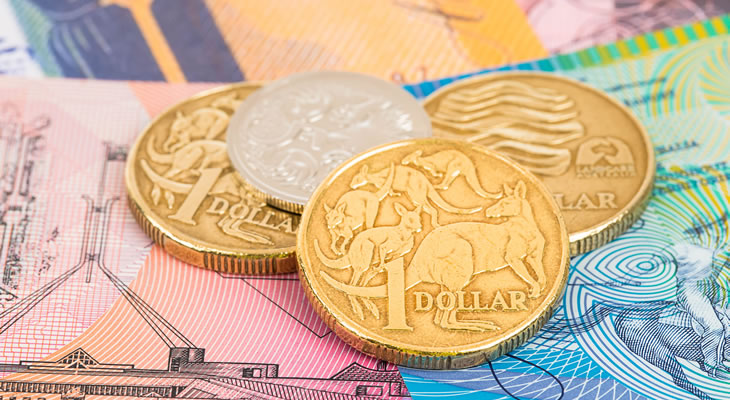- UK Construction PMI plunged into contraction territory – GBP AUD exchange rate weakened by discouraging sign of economic slowdown
- RBA left interest rates unchanged for another month – ‘Aussie’ shored up by improved investor confidence
- GBP AUD exchange rate at multi-year low after disappointing Services PMI – Worries over outlook of UK economy intensify
- Outcome of federal election could provoke Australian Dollar volatility – Hung parliament likely to reduce demand for antipodean currency
‘Aussie’ Weakens as Markets Continue to Price in August RBA Rate Cut
Although US data continued to show signs of weakness risk appetite thinned somewhat overnight, reducing the gains of the Australian Dollar (AUD). With markets still confident that the Reserve Bank of Australia (RBA) will cut interest rates in August there has been limited reason for investors to buy into the antipodean currency. As a result, despite a lack of UK data, the GBP AUD exchange rate was trending narrowly around 1.7402 on Wednesday morning.
(Previously updated at 16:02 on 05/07/2016)
The appeal of the Pound has been somewhat lacking thanks to a poor raft of UK PMIs, prompting the GBP AUD exchange rate to shed further ground this week.
Poor UK Construction PMI Prompted Sharp Pound (GBP) Downtrend
Although some of the turmoil in the British political landscape eased this week, the mood towards the Pound (GBP) remained decidedly bearish. Contenders for the Conservative leadership offered various timeframes for the activation of Article 50, giving markets little clarity over when the formal exit process from the EU is likely to start. This continued sense of uncertainty did little to benefit Sterling, despite Chancellor of the Exchequer George Osborne suggesting that corporation tax could be cut to encourage continued investment into the UK economy.
Sentiment towards the Pound soured further on Monday morning when the June Construction PMI was published, falling substantially short of expectations. While investors had anticipated a modest slowdown in growth, the slump from 51.2 to 46.0 provided significant cause for concern. Consequently, with optimism shot, the Pound to Australian Dollar (GBP AUD) exchange rate extended its downtrend. As the survey was mostly compiled before the outcome of the EU referendum was known this offered a particularly worrying indication of the domestic economy’s health.
The ‘Aussie’ (AUD), on the other hand, was not particularly weighed down by the lack of clear result from the latest federal election. With pre-poll and declaration ballots still to be counted, markets were not especially concerned by worries over a potential hung parliament, particularly as commodity prices rallied strongly. Risk appetite benefitted from the holiday closure of the US markets, with the limited strength of the US Dollar (USD) offering further support to the antipodean currency.
Australian Dollar Extended Gains over Pound after RBA Left Interest Rates on Hold
Investors were somewhat reassured by the Reserve Bank of Australia’s (RBA) decision to leave interest rates unchanged for another month. There had been some speculation that market unrest caused by the Brexit vote could force the RBA’s hand and trigger further monetary loosening, although this did not come to pass. With the chances of a 2016 Federal Reserve interest rate hike seeming severely limited at this juncture the pressure on Australian policymakers appears reduced, allowing them to maintain a more neutral stance on monetary policy. As researchers at TDS noted:
‘There was no explicit easing bias left on the table, and the only material change in the statement was a nod to monitoring any impact from the Brexit vote.’
A reassuring Chinese Services PMI also helped to shore up demand for the Australian Dollar on Tuesday, as the sector showed further signs of strengthening and offset a more disappointing manufacturing figure. Even so, the appeal of commodity-correlated currencies remained somewhat muted due to wider market worries.
Ahead of the Bank of England’s (BoE) latest Financial Stability Report, confidence in the Pound continued to slide. Although the UK Services PMI did not fall into contraction territory investors were not overly encouraged by its return to a thirty-eight month low of 52.3 in June. This furthered concerns that the domestic economy is in for a rough time once data begins to reflect the impact of the Brexit result, appearing to increase the odds of a return to recession. With three prominent property funds suspending withdrawals in short succession worries over the outlook of the UK continued to mount, adding downside pressure to the Pound.
GBP AUD Exchange Rate Forecast: Australian Election Deadlock Could Weaken ‘Aussie’
Once the final results of the Australian election become clear the ‘Aussie’ could see renewed volatility, particularly if the last seats are not enough to avert a hung parliament. A lack of clear victor would not bode well for the outlook of the domestic economy, with fiscal policy likely to be hampered by ongoing political uncertainty. Nevertheless, if the latest Federal Open Market Committee (FOMC) meeting minutes offer further evidence of a dovish mentality, the Australian Dollar could still see support tomorrow.
Thursday’s UK Industrial and Manufacturing Production figures may reduce the appeal of the Pound further, with additional signs of weakness within the economy likely to keep markets in a bearish mood. Also of importance will be the NIESR Gross Domestic Product Estimate for June, which is likely to signal a continued slowdown. An upside surprise, on the other hand, could see the GBP AUD exchange rate return to a stronger footing later in the week.
Current GBP, AUD Exchange Rates
At the time of writing, the Pound to Australian Dollar (GBP AUD) exchange rate was slumped around 1.7504, while the Australian Dollar to Pound (AUD/GBP) pairing was making gains in the region of 0.5710.


Comments are closed.